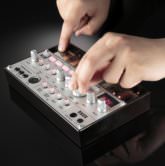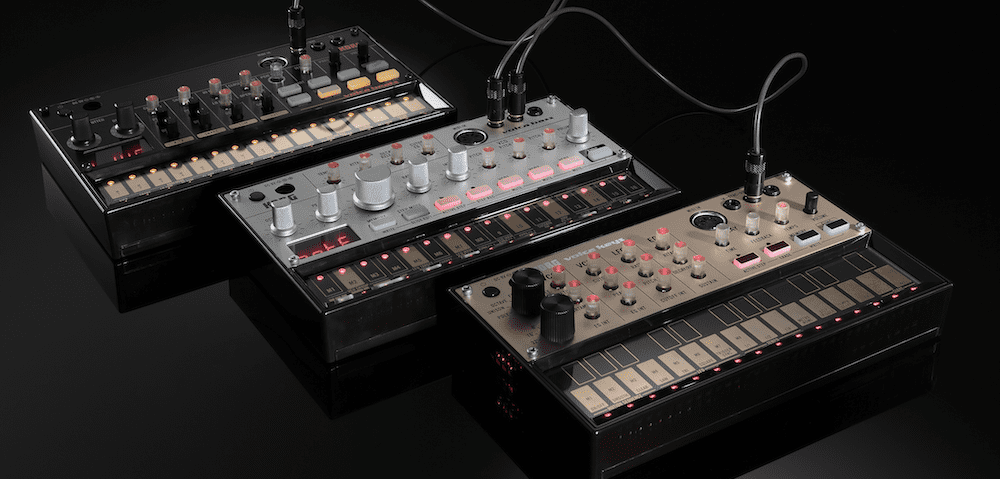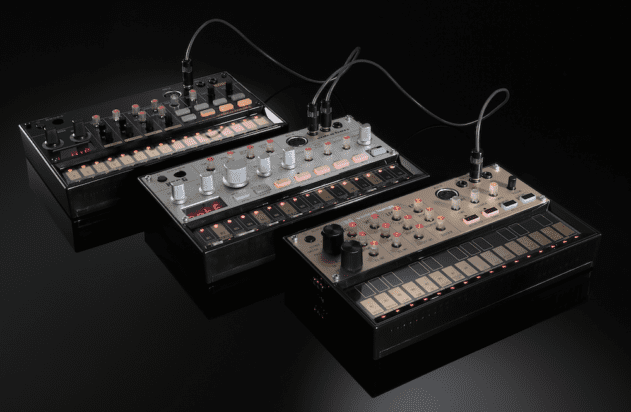Korg’s new Volca boxes offer analogue drums and 303-style synth grooves at an incredible price. Do they live up to the hype? Greg Scarth puts them to the test.
Strange things have been brewing in Korg’s research labs in recent years. At 2010’s Musikmesse conference, the company announced the Monotron, its first analogue product for decades. Since then we’ve had the Monotribe, the Monotron Duo and Delay, and finally the MS-20 Mini, a scaled down version of the 70s classic.
Unlike certain Japanese rivals, Korg seem to realise that musicians and producers still covet analogue gear. Since the release of the Monotron it’s been obvious that Korg were working toward something bigger: the Monotribe added drums, introduced oscillator auto-tuning for pitch stability, and even included secret, DIY-friendly MIDI support. The MS-20 Mini then proved that it is possible for the Japanese giants to build authentic reissues of older gear.
Korg seem to realise that musicians and producers still covet analogue gear.
Where are Korg ultimately heading with all of this? We’re not quite sure. An all-new analogue monosynth? A budget analogue polysynth? Either way, the next step is to refine the lessons of the Monotrons, Monotribe and MS-20 into a new range of compact, step sequencer-based grooveboxes: the Volca range.
Three Volcas
The Volca units come in three flavours, the first of which to grab our attention was the Bass. There’s no denying that this is a unit very similar in spirit to the TB-303 – a relatively basic three-part monophonic synth triggered by a built-in step sequencer. Its three oscillators can be sequenced together or individually, then fed through a filter derived from the MiniKorg 700S. There’s also an LFO which can be assigned to any combination of pitch, amplitude and filter cutoff.
 The Volca Beats has similarities with Korg’s own KPR-77, but let’s be honest: the first thing you think of when asked to name a small, affordable, analogue drum machine with a 16-step sequencer is much more likely to be Roland’s TR-606. In this case the sound sources are mainly analogue with a handful of sampled sounds thrown in. There’s also a built-in stutter effect.
The Volca Beats has similarities with Korg’s own KPR-77, but let’s be honest: the first thing you think of when asked to name a small, affordable, analogue drum machine with a 16-step sequencer is much more likely to be Roland’s TR-606. In this case the sound sources are mainly analogue with a handful of sampled sounds thrown in. There’s also a built-in stutter effect.
The third and final product in the range is the Volca Keys, which initially seems similar to the Bass. The crucial difference is that the Keys offers a more conventional approach to three-note polyphony. Instead of three separate oscillators, the Keys is based around an oscillator cluster with a selection of six different modes for achieving a range of timbres. The filter is a slightly different variation on the same MiniKorg-derived circuit found in the Bass. The Keys also features a built-in delay effect.
Overview
Bigger than a Monotron but smaller than a Monotribe, the Volcas clearly fit into the lineage of the classic compact grooveboxes and drum machines. It’s nearly impossible not to make reference to classics like the TB-303 and TR-606 when discussing them, and the comparisons are justified to some extent: the Volcas are affordable, portable and battery-powered. Wouldn’t Korg’s Electribes be a more logical comparison? Well, yes and no. Although there are similarities, the Volcas are a little more limited. Where the Electribes can build up entire tracks from multiple synth and drum parts, the Volcas offer fewer options. The Beats can only do drums, the Keys can only play one timbre and part at a time, while the Bass can play three parts simultaneously but all must use the same filter, LFO and envelope settings.
The Volcas focus on hands-on performance and real-time manipulation rather than programming full tracks. There’s no song arrangement mode; you can store eight patterns in each unit, but you’ll have to switch between them manually rather than chaining them together to form a full track arrangement. If you want to build up more complex multi-part tracks you’ll need to sync multiple units together; they can sync via a 3.5mm cable or over MIDI (the Volcas use the same sync signal as the Monotribe, so that can join in too).
Build quality is more than satisfactory at this price point. Although they’re clearly not in the same league as something like, say, a Maschine or a Push, the Volcas feel like they’ll take a fair amount of abuse. The majority of the knobs are the same splined plastic shafts found on the Monotron and Monotribe, with larger knobs for more important controls such as filter cutoff on the Bass.
The Volcas focus on hands-on performance and real-time manipulation rather than programming full tracks.
The built-in mono speakers are situated underneath the units, which means they sound very muffled when used on anything but a hard surface (such as, say, your leg while you sit and watch TV – let’s be honest, the Volcas are probably going to be used in that kind of setting just as much as they get used for ‘proper’ studio work), but the 3.5mm headphone socket can be used as a line out, which reveals that the sound is a lot more impressive than the built-in speaker might initially suggest. The kick drum on the Beats, for instance, sounds just as weedy as you’d expect through the tiny speaker, but packs a decent punch when hooked up to a proper monitor.
The ribbon controllers are a notable step up from the Monotron and Monotribe; larger, more clearly marked and much easier to use – 27 keys on the Keys, 16 keys on the Bass, 16 steps on the Beats.


09.14 AM
Check that crazy demo of the Korg Volca Beats
http://youtu.be/tz2cwESyzeI